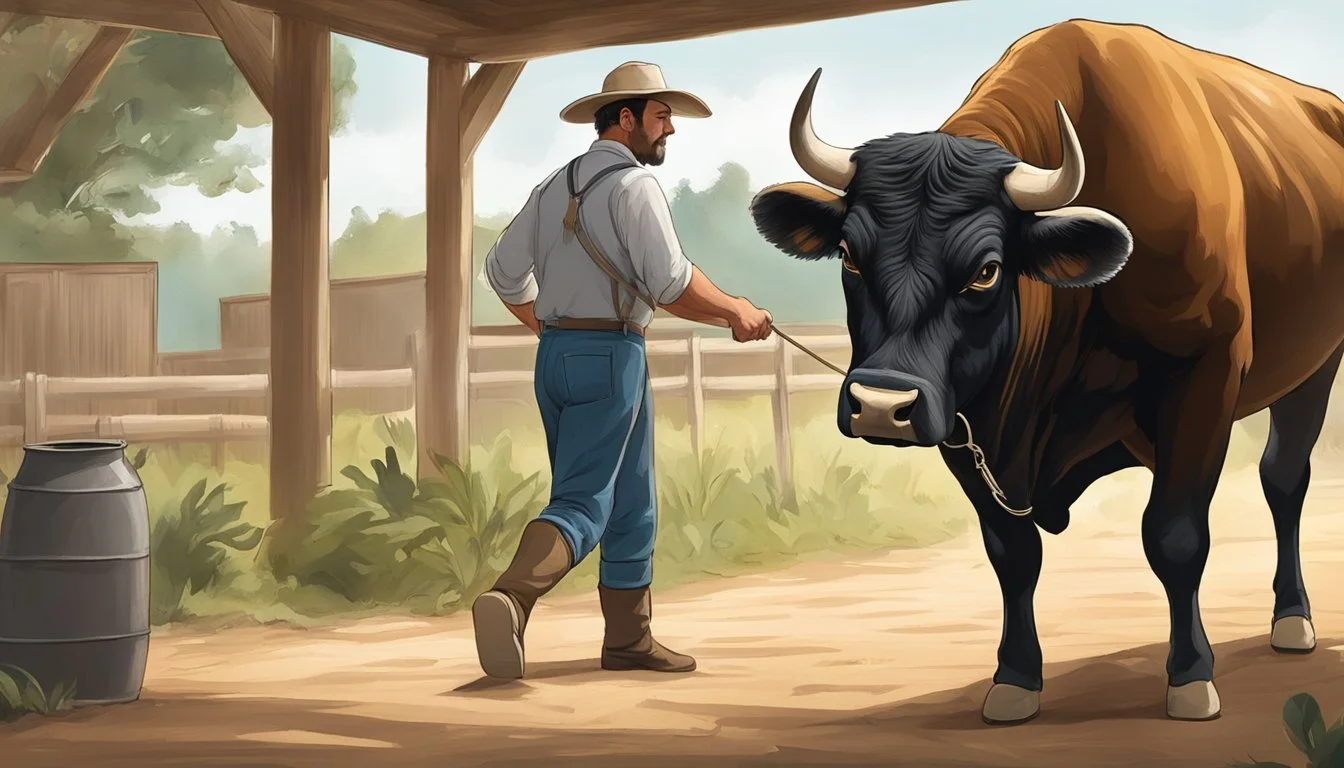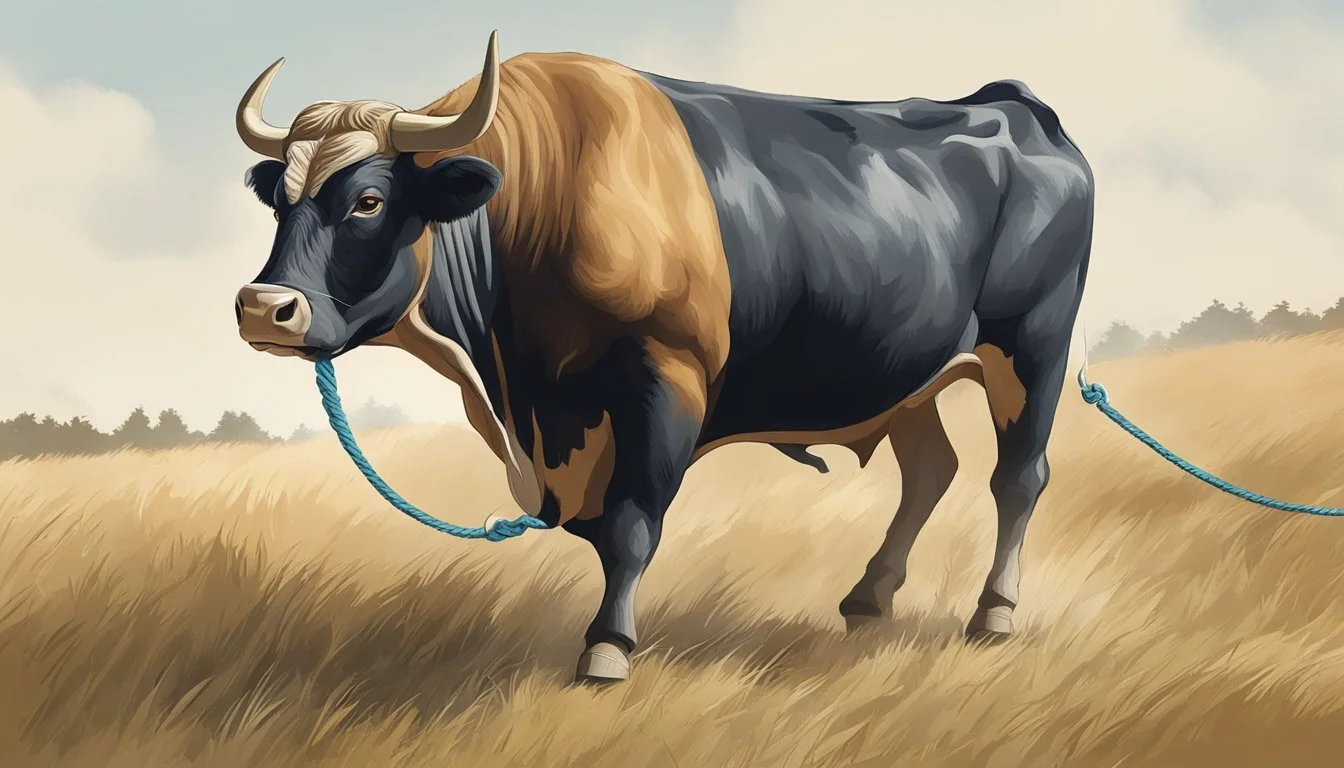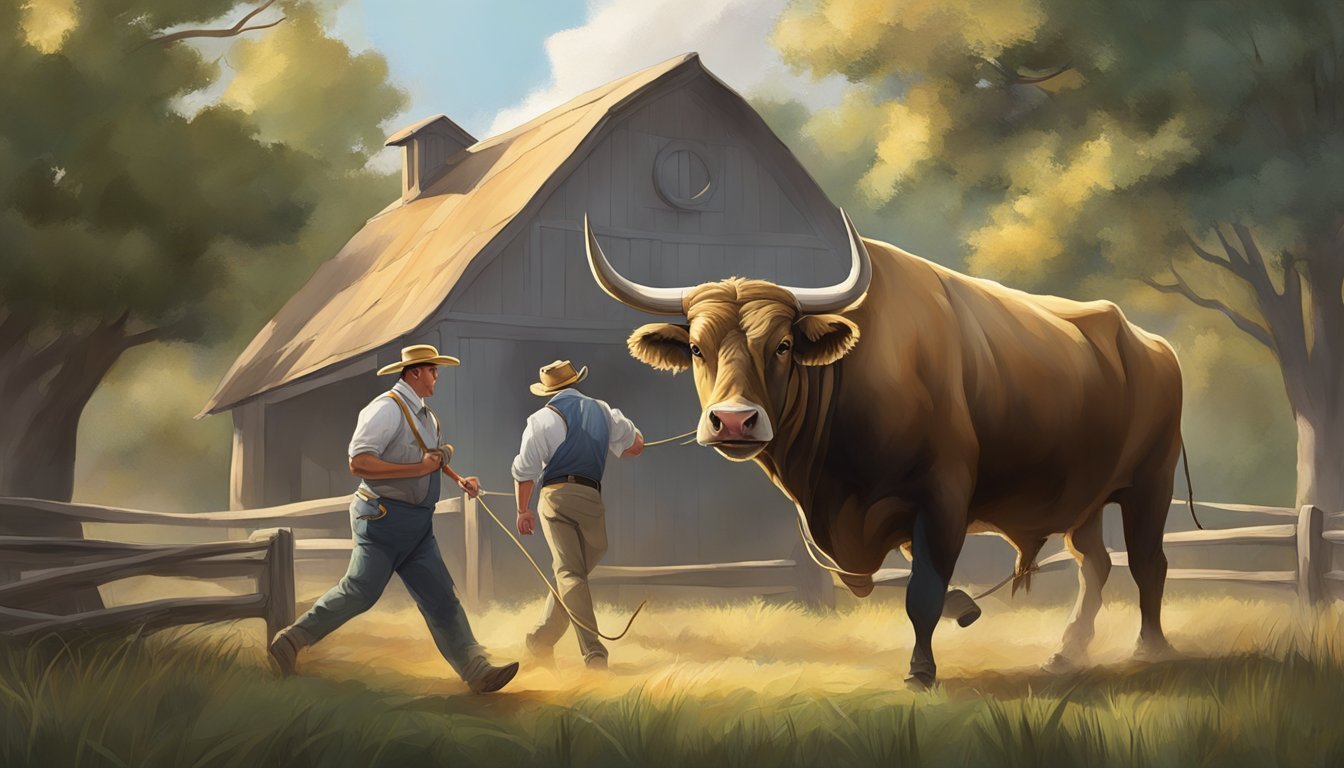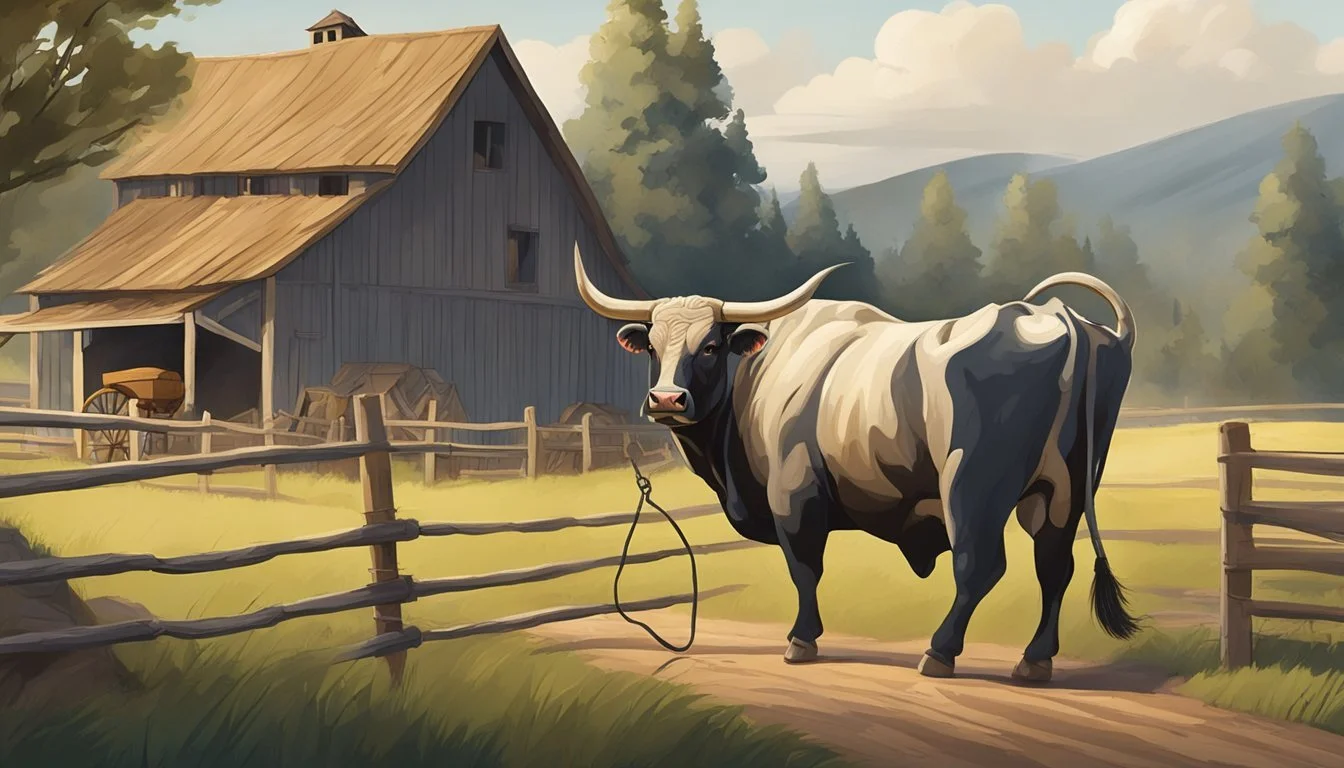Mastering Bull Handling
Ensuring Safety with a Nose Ring Lead on the Homestead
In the realm of cattle management, the use of nose rings is a well-established practice, particularly when it comes to bulls. The presence of a nose ring serves as an integral tool for handlers by providing them with a means to guide and control these powerful animals with more ease and safety. Safety is paramount in homesteading where handling livestock is a daily activity, and the use of nose ring leads allows for a calmer and more controlled environment.
The effectiveness of the nose ring is rooted in the sensitivity of the bovine nasal area. By attaching a lead to the nose ring, handlers can direct a bull with minimal force, reducing the risk of injury for both the animal and the handler. In settings such as farms, veterinary practices, and during transport, the nose ring is particularly useful. It affords a level of control that is essential in preventing potentially dangerous situations that can arise with an uncooperative or distressed bull.
For those involved in homesteading, mastering the use of a nose ring lead is an important skill. Understanding the correct placement and usage of nose rings ensures that bulls can be led safely for routine tasks such as feeding, medical treatment, and breeding. The choice to utilize a nose ring also reflects a commitment to maintaining a safe working environment, showcasing both responsible animal husbandry and an adherence to best practices in livestock management.
Understanding Bull Behavior
In managing bulls, it's imperative to recognize their natural disposition and the aggression signals they may exhibit. This insight is crucial for fostering an environment that supports both animal welfare and farm safety.
The Nature of Bulls
Bulls are large, powerful animals with instincts that can influence their behavior on the farm. Their well-being is significantly affected by environmental factors such as space, herd dynamics, and treatment by handlers. Stress can be a major issue if not managed properly, and a stressed bull may become unpredictable.
Aggressive Behaviors and Signs
Bulls may display aggressive behaviors that can pose serious risks to handlers and other animals. Some indicative signs of aggression include:
Pawing at the ground
Snorting or bellowing
Head tossing
Staring intently
Tail lashing
Quick identification of these behaviors helps in mitigating stress and potential harm, aligning with optimal standards of animal welfare.
The Role of the Nose Ring in Bull Handling
Nose rings are a critical tool in managing and controlling bulls by applying pressure to one of the most sensitive areas of these powerful animals. They enable handlers to guide a bull with more safety and assertiveness.
Historical Significance
Ancient civilizations recognized the utility of nose rings for controlling large animals. In bull handling, this methodology has been an integral aspect of domestication. The inclusion of a nose ring allows for a physical connection that transfers the handler's intentions directly to the animal, encouraging compliance without extensive force.
Physical and Behavioral Control
Bulls possess inherent strength that presents a constant challenge in management. Nose rings serve as a method to exert control by leveraging the physical sensitivity of the bull's nose. When a lead is attached to the nose ring, minimal effort can redirect a bull's movements, as the discomfort prompts the animal to avoid pain by following the handler's guidance. This plays on the bull's natural behavior, where the avoidance of pressure and pain results in compliance.
Comparison to Other Physical Restraint Techniques
Other physical restraints, such as headlocks or fenced enclosures, restrict movement but may lack the finesse and immediate control that a nose ring provides. While these techniques have their place:
Headlocks secure a bull in a fixed position for a short time.
Enclosures limit a bull's free range but do not aid in movement from point to point.
Nose rings offer a balance of control and mobility; by applying pressure to the sensitive nasal area, the handler can guide the bull effectively. This contrasts with methods that either constrain the animal entirely or require significant physical strength and risk to the handler.
Choosing the Right Nose Ring
Selecting an appropriate nose ring for bulls is critical for effective handling and safety on a homestead. The type and quality of the nose ring determine both durability and function.
Types of Nose Rings
Nose rings for cattle come primarily in two forms: the simple ring and the hinged or locking ring. The simple ring is a continuous loop that offers basic control, while hinged or locking rings provide added security as they can be opened or closed for ease of installation.
Simple Ring: Ideal for basic control during routine handling.
Hinged/Locking Ring: Better for more intense scenarios or for animals that are frequently moved or shown.
Materials and Durability Considerations
The material of a nose ring affects its strength, longevity, and safety. Stainless steel and brass are common choices:
Stainless Steel: Resilient and resistant to rust, making it suitable for long-term use.
Pros: High durability, low maintenance
Cons: Can be more expensive
Brass: Less robust than stainless steel but offers a balance between strength and cost.
Pros: Cost-effective, reasonable durability
Cons: More prone to wear and tarnish
One should consider the presence of a chain, which can be connected to the nose ring, adding control while leading or tethering the animal. Quality is paramount; a nose ring should withstand significant force without deforming.
Quality Considerations:
No Spikes: Avoid designs with sharp edges or spikes to prevent injury.
Thickness: A thicker gauge indicates stronger resilience.
Closure Mechanism: Should be secure to prevent accidental opening.
The right nose ring is one that balances control, animal welfare, and the longevity of the tool. Homesteaders must weigh these factors to ensure their practices are both humane and effective.
Nose Ring Installation: Procedure and Precautions
Installing a nose ring in bulls is a critical procedure for safe handling, requiring careful execution and attention to minimize pain and prevent infections. This section outlines the correct steps for installation and care.
Steps for Safe Installation
Preparation: The veterinarian ensures that all instruments are sterilized before the procedure. They then calm the bull in a secure area to prevent sudden movements.
Application: Using a specialized clamp, the veterinarian precisely positions and pierces the nasal septum. This tool ensures accuracy and reduces unnecessary tissue damage.
Minimizing Pain and Discomfort
Use of Anesthetics: A veterinarian administers local anesthetics to the bull's nose to alleviate discomfort during the piercing.
Efficient Technique: Swift and confident actions by the veterinarian minimize the time taken and discomfort experienced.
Infection and Long-term Care
Post-Installation Cleaning: The area around the newly installed nose ring is cleaned to eliminate any debris and minimize the risk of infection.
Regular Inspections: Routine checks for signs of infection, such as swelling or discharge, and appropriate treatment, including antiseptics or antibiotics, are necessary for long-term care.
Training Bulls with Nose Rings
Nose rings are a vital tool for the effective training and handling of bulls, providing farmers with the means to guide these powerful animals safely through trust-building and specialized lead rope techniques.
Building Trust Through Guiding
Establishing a solid foundation of trust between the handler and bull is essential for safe interaction. Handlers initiate this process by gently guiding the bull with the nose ring, associating the handler's presence with a sense of security. Consistent interaction with the lead rope attached to the nose ring helps in reinforcing trust, as the bull learns to follow leads with minimal resistance.
Step 1: Approach the bull calmly to prevent startling it.
Step 2: Attach the lead rope smoothly to the nose ring without sudden movements.
Step 3: Guide the bull with consistent, gentle pressure and reward calm behavior.
Effective Lead Rope Techniques
Utilizing proper lead rope techniques ensures control and cooperation during training. Handlers must employ steady, assertive tugs on the lead rope to direct the bull's movement, avoiding harsh or unpredictable jerks that could cause distress or agitation.
Technique 1: Use short, deliberate tugs to signal the desired direction.
Technique 2: Maintain a firm grip and steady stance to stay in control if the bull resists.
Technique 3: Apply varying pressure smoothly to steer the bull, increasing responsiveness.
Through these methods, a handler can mold a responsive and manageable bull, embodying the balance between discipline and welfare in homesteading practices.
Managing Bulls During Routine Tasks
Handling bulls necessitates a comprehensive strategy that ensures their wellbeing while also keeping farm workers safe. From feeding practices to health management, every interaction with these powerful animals should be planned and executed with care.
Feeding and Nutrition
Feeding:
Provide a balanced diet that includes grains, forages, and supplements to meet the nutritional needs of bulls.
Maintain a regular feeding schedule to reduce stress and prevent competitive behavior among bulls.
Water:
Ensure constant access to clean water; bulls require up to 20 gallons per day.
Nutrition Monitoring:
Monitor body condition regularly to adjust food intake, especially before and after the breeding season.
Breeding and Weaning
Breeding:
Observe bulls for proper behavior and condition during breeding season to ensure effective mating.
Manage bull-to-cow ratios adequately to prevent overworking the bull and compromising herd genetics.
Weaning:
Introduce weaning practices calmly to reduce stress on both the bull and the calves.
Separate bulls well before weaning to stabilize herd dynamics.
Health Checks and Veterinary Visits
Routine Examinations:
Conduct regular health checks, including fertility tests before the breeding season.
Look for signs of lameness, weight loss, or other health concerns.
Veterinary Care:
Schedule vaccinations and parasite control measures to prevent disease.
Arrange for prompt veterinary attention if a bull shows abnormal signs or behaviors.
By adhering to these specific and deliberate practices during routine tasks, homesteaders can maintain a safe and productive environment for bulls.
Equipment Associated with Nose Rings
When handling bulls, utilizing proper equipment is essential for safe and effective management. This section outlines the equipment closely associated with nose rings, which are pivotal in bull handling.
Halter and Lead Systems
A halter is a vital piece of equipment that fits on a bull's head, providing the handler with control and direction. Most commonly made from durable materials, halters ensure secure handling when combined with a nose ring. The lead, which often attaches to the nose ring, augments this control. It is typically a sturdy rope or a strap that gives the handler the leverage needed to steer the bull safely.
Common Halter Materials:
Leather
Nylon
Rope
Lead Components:
Clip or Hook: Secure attachment to nose ring
Handle: Often made of the same material as the lead for consistency
Other Handling Tools
In addition to halters and leads, other implements can be utilized to enhance the safety and efficacy of bull handling. A tong, for example, provides a means to guide bulls from a safer distance during movements. Handlers might also use a metal pole with a hook at the end to gently guide the bull without direct contact. It's crucial that these tools are used with precision and an understanding of bovine behavior to ensure the safety of both the handler and animal.
Typical Handling Tools:
Tongs: Usually made of metal for durability
Metal poles: Extend the handler's reach
Hooks: Attach to equipment, allowing for adjusted control
Ethical Considerations and Animal Welfare
In managing bull handling on homesteads, the implementation of a nose ring lead must be examined through the lens of animal welfare and ethics. These considerations are paramount to ensure the treatment of bulls aligns with established legal standards and moral expectations.
Respect for the Animal
The use of a nose ring lead in bull handling should affirm the animal's integrity and minimize distress. Animal welfare involves the animal's psychological state and the impact handling practices have on their well-being. Ethical treatment requires that any discomfort caused by the nose ring is outweighed by the safety it provides to both the bull and the handler.
Pain and stress minimization: It is imperative to apply the nose ring with precision and care, utilizing proper techniques to mitigate pain.
Monitoring and aftercare: Regular checks ensure the nose ring does not cause ongoing distress or injury, respecting the animal’s welfare post-application.
Regulations and Best Practices
Adherence to regulations and best practices ensures that the treatment of animals on homesteads complies with ethical standards.
Legal requirements: Handlers must stay informed of and comply with local and national laws governing animal treatment, which often outline acceptable methods and equipment use.
Training and competence: Only trained individuals should apply and utilize nose ring leads, ensuring the procedure is performed correctly and humanely.
Handlers should prioritize these ethical aspects, balancing human safety and animal welfare in the practice of bull handling.
Advanced Applications of Nose Rings
Nose rings in cattle, particularly in bulls, serve more than just a basic function. They are crucial in specific scenarios where control and safety are paramount.
Bulls in Shows and Rodeos
In the competitive and highly-regulated environments of shows and rodeos, the use of nose rings is a standard practice for managing show bulls. This practice is not just for aesthetics; it provides handlers with a means to guide powerful bulls safely through crowded spaces. It is a requirement in many cases for bulls to have nose rings to ensure the safety of both the animals and the attendees. Typically, a lead attaches to the nose ring, allowing for precise control.
Control: Nose rings offer handlers the leverage needed to manage bulls amidst the bustling atmosphere of shows and rodeos.
Safety: The rings make it safer for both the animal and humans interacting with them, reducing the risk of accidents.
Transportation and Movement
During transportation and general movement between locations, a nose ring becomes an essential tool for directing bulls safely. Movement can be a stressful experience for large animals, and the bull's nose ring allows handlers to maintain control, which is especially critical in unpredictable situations.
Ease of Transport: A nose ring simplifies the movement of bulls between different sections of a farm or to various events.
Enhanced Safety: When leading bulls to load or unload from transport vehicles, the added control from a nose ring is invaluable for preventing potential injuries.
In both scenarios, the nose ring is more than an accessory — it is a key component in ensuring the welfare of the bulls and the safety of those around them.
Conclusion
In the realm of homesteading, the use of a nose ring lead is a pivotal measure for safe and effective bull handling. It allows for the control of these powerful animals, minimizing risks to both caretakers and livestock. Preparing to manage a bull requires a detailed understanding of the animal's behavior, and the nose ring is a tool that leverages a bull's natural sensitivity for compliance and safety.
A properly installed nose ring serves multiple functions:
Control: It acts as a critical point for handlers to direct a bull with precision during movement.
Safety: The additional leverage it provides ensures the safety of handlers during close interaction.
Behavioral Management: The ring is a pivotal element in influencing a bull's actions and preventing undue aggression.
Essential for livestock handling success are the following practices:
Utilizing a nose ring lead only when necessary and with the utmost care.
Ensuring that all individuals involved in handling are trained in its use and the understanding of bull behavior.
Regular maintaining and checking the integrity of the ring to prevent injuries and to maintain its effectiveness.
The nose ring lead should be seen as a part of a broader toolkit—a commitment to safety and preparation that embodies responsible livestock stewardship. Farms that prioritize these tenets can maintain a safer environment for both their animals and their humans. Homesteaders must employ this tool respectfully and judiciously, always upholding the highest standards of animal welfare.










